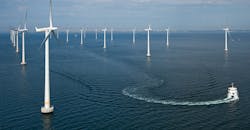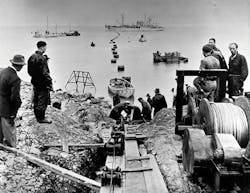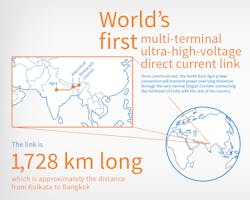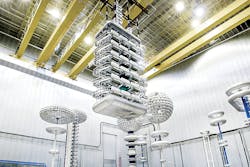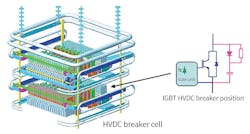There is little agreement on how exactly today’s power grid will change in the next 10 to 20 years, which is understandable. When considering all the forces affecting the grid and all the technologies available, there are many combinations to choose from and directions to go. Interestingly, one topic keeps coming to the top of the forums: More capacity is needed because the high-voltage alternating-current (HVAC) transmission grid is heavily loaded. Linked to this is the fact an extreme amount of intermittent renewable energy needs access to the grid, which is mostly remote compared to the load centers needing power.
To address this conundrum, tomorrow’s grid must carry more power over greater distances and provide more reliability for that electricity. One of the most exciting solutions to this issue is the movement toward a power grid that includes a high-voltage direct-current (HVDC) transmission grid overlaid on the HVAC transmission system. Some have called it a super grid or a mega grid while others refer to it as a hybrid HVAC-HVDC grid, but mega grid fits this discussion more appropriately.
The Mega Grid
The mega grid is a wide-area transmission network that makes it possible to trade high volumes of electricity across great distances, and HVDC fits right into this application. As fortune would have it, a great deal of HVDC transmission has been installed worldwide. The chief benefit is HVDC is ideal for extreme long-distance transmission. According to an Electric Power Research Institute (EPRI) technical report, "Unlike HVAC, the current in an HVDC system travels through the entire cross section of a conductor and needs fewer individual strands and less cross-sectional conductor area, enabling it to move energy over greater distances with less power loss."
HVDC also enables continental-scale transmission of power crossing time zones, connecting asynchronous networks and providing power transfers between different systems designed to run at different frequencies. Also, HVDC systems can carry two to five times the capacity of an HVAC transmission line with the same right-of-way. It is used to transport large blocks of power over great distances and seems like a good start to the capacity issue.
Unfortunately, turning these HVDC schemes into HVDC grids has been a problem the industry has been dealing with for many years. However, in the last few years, this has changed because of a great deal of research and development by the industry’s manufacturers. They have been developing the tools needed to connect HVDC schemes into grids. Many challenges still face the industry before a HVDC grid is ready for deployment, but the challenges are manageable.
Managing and controlling such an HVAC-HVDC mega grid scheme may be as much of a challenge as actually building it because of the interface between the HVAC and HVDC systems. The interactions between the HVAC and HVDC networks are very complicated; there are complex dynamics between converter stations, the power flow and the exchange of power across the HVAC and HVDC interconnections. Suitable control strategies must be developed and implemented to address and manage the many functions involved, such as power flow and voltage deviations in operating the HVDC grid.
The HVDC grid needs a supervisory control system to manage everything from coordination of power-injection points to fast control of active and reactive power components. In addition, protection issues — such as how the lines are protected, faults are detected, protective devices are coordinated and faulted elements are isolated — must be defined. Managing and controlling this type of grid also requires features that enable HVAC system operators to optimize power-flow schedules based on system economics and security requirements. All these subjects are going to require a great deal of research and study to develop the simulation tools required to model the networks, but this does not imply it is all new territory.
HVDC Component
The HVAC transmission grid has had embedded HVDC since the early 1950s, and both components have operated together without any control problems. In fact, the HVDC component has provided stability and support over the years. Ram Adapa, an EPRI technical executive in HVDC and power electronics, explained, "Currently, more than 200 HVDC systems are operating around the world and many new HVDC projects are being planned. HVDC grids that overlay the AC network are being seriously considered for the future development of the electric power system. At present, no high-voltage HVDC grids are operating, although multiterminal HVDC transmission systems are in service."
In looking at the basic HVDC topologies available for the HVDC grid designs, the oldest HVDC technology is the line-commutated converter (LCC), also called a current source converter. It is thyristor based and requires a relatively strong synchronous voltage source to operate. The other topology is the self-commutating voltage source converter (VSC), based on devices with turnoff capability such as insulated-gate bipolar transistors (IGBTs). Each scheme has its strengths and weaknesses, but the main point is these two technologies are not competitors, they are complementary technologies. These schemes are expected to be the building blocks for the HVDC grid and used in the proposed HVAC-HVDC mega grid.
These grid building blocks are configured in three schemes: point to point, back to back and multiterminal. In case this is unfamiliar technology, a point-to-point system consists of two converters, one for each end of the HVDC line, and both converters are connected to the HVAC grid. The back-to-back system configuration connects two adjacent HVAC systems through a DC link with all conversion taking place in a valve hall within one station. The multiterminal system has several converters at different locations connecting to a common HVDC line, enabling multiple points of input and output of power. There are no meshes and no redundancy, only an alternate path to the HVAC grid.
Many experts predict multiterminal configurations are the first step in developing the future HVDC grid, necessary for the mega grid. As an example, the Power Grid Corp. of India’s North-East Agra (NEA) power project is a big step in developing experience in one of the mega grid’s building blocks. NEA is the world’s first multiterminal ultrahigh-voltage direct-current (UHVDC) transmission system. It is rated ±800 kV with 8000 MW of converter capacity, when completed.
A project spokesperson said, "The project is being executed by ABB together with Bharat Heavy Electricals Ltd. (engineering and manufacturing company), a leading government-owned power company, on a turnkey basis including design, system engineering, supply, installation and commissioning. The link comprises four terminals in three converter stations with a 33% continuous overload rating, enabling an 8000-MW conversion. NEA is one of the most powerful HVDC transmission systems ever built. One converter station will be in the northeastern state of Assam and a second in the state of West Bengal in eastern India. The other end of the DC line will terminate at Agra, where two bipolar converters will be connected in parallel."
LCC technology has been the major technology in multiterminal projects for many years, but that is changing as VSC technology matures and advances. An example of a multiterminal system is the State Grid Corp. of China’s ±200-kV Zhoushan project. Supplied by NR Electric, among others, the VSC-HVDC multiterminal project has a total sum converter power of 1000 MW.
According to NR Electric, this is the world’s first five-terminal VSC transmission project. Located in the Hangzhou Bay, it provides power to the Zhoushan islands: Dinghai, Daishan, Qushan, Yangshan and Sijiao. Prior to the VSC-HVDC, all the existing mainland and inter-islands were powered by a weak and unreliable HVAC system. The VSC-HVDC scheme interconnects the islands with the China transmission system and provides reactive power compensation to stabilize the island grid. This system is operated in parallel with the existing HVAC system. The VSC-HVDC project has been in service since 2014 and proven itself by providing valuable operational data on a VSC-HVDC multiterminal interacting with an HVAC system.
Manage the Mega Grid
When it comes to the HVDC grid, LCC and VSC technologies are critical to the development of the mega grid. The LCC scheme today can carry larger amounts of power at higher voltage levels over long distances, but VSC technology has many positive attributes needed for the HVAC-HVDC grid. It provides an easy method to control the power flow’s direction, which is needed for managing and controlling HVAC-HVDC mega grids. VSC technology can adjust the power flow’s direction by changing the direction of the current and not the polarity of the DC voltage as LCC technology requires.
The LCC and VSC act differently on the AC side and the DC side, which adds to the challenge of controlling and managing an HVAC-HVDC grid. On the AC side, the LCC acts as a current source, requiring a lot of AC filtering and reactive compensation. The VSC acts as a voltage source, and its most modern incarnation does not need filters or a reactive power supply. On the DC side, the LCC needs DC filtering and the VSC does not need any additional filtering.
Also, the two HVDC technologies react differently to system disturbances on the HVAC and HVDC grids. The LCC system is largely passive, so its response to an HVAC fault is limited and there is little control action it can take. Because of the VSC’s characteristics, it responds as a voltage source to an HVAC fault and can, in many cases, continue supporting the grids even during faults. It also can respond quickly to other system disturbances, such as power swings, by keeping the system stable. These are important attributes when designing HVDC grids to be included in the deployment of HVAC-HVDC mega grids.
There are other interesting VSC-HVDC technical features for future mega grid applications, including power-flow control flexibility and fast response to disturbances. Also, VSC-HVDC has the capability of independent control over both active and reactive power, independent of each other, which keeps the voltage and frequency stable. VSC-HVDC systems can be used to transmit power underground, underwater and overhead, which provides plenty of options for an HVAC grid embedded with HVDC. Attributes such as these make it feasible to dispatch VSC-HVDC systems in real-time power grid operations, making these schemes more economical. They also can be used to manage congestion effectively on the HVAC grid.
Now an ideal technology exists for the development of an interconnected HVDC grid that can make HVAC-HVDC grids possible. The next step is to connect the existing HVDC lines and optimize the reliability of the network. Why not interconnect these lines into a grid?
Hybrid DC Breakers
To build an HVDC grid, being able to configure HVDC elements into a network is critical. This is possible only with the application of DC circuit breakers. The DC breaker has been available for many years, but there is a problem with the old-school devices. They are based on electromechanical technology, which is not very fast. The existing breakers are capable of operating on the order of 100 msec, which is too slow to meet the requirements of a modern HVDC grid. The breakers also need a resonance circuit to generate a current zero for the breaker to be able to interrupt the current once opened.
The breakthrough came in 2011, when ABB announced it had invented a hybrid DC circuit breaker. This device uses a combination of mechanical switching and solid-state (IGBT) power electronics to solve the problem. It is a modular design with fast DC current measurement capability for control and protection, and it is robust enough to isolate faults and reroute power. The hybrid DC breaker’s operation is fast, clearing faults in approximately 5 msec. It also is possible to balance loads between elements and maintain power flows even if there is a fault on one of the HVDC lines.
With the hybrid DC breaker, HVDC grid designers now have the same abilities to join HVDC transmission lines and form HVDC power mesh grids, which is necessary for a HVDC network.
Making It Happen
In addition to the massive technological challenges of constructing a mega grid, there are going to be bigger challenges with managing the mega grid, especially around marketing and institutional developments. Changes will be needed to codes, standards, operating procedures and policies, to name a few. This is especially true when the mega grid crosses regional borders, national boundaries and other borderlines. Political approvals are probably going to be one of the most critical undertakings as the grid spans continents. Without significant support from all the appropriate governmental agencies, federations and other official entities, building a mega grid will be difficult, if not impossible.
Another critical part of the management of the grid is financial. Financial backing is probably going to be the second most critical item, as this endeavor will require very large investments.
After those issues are moving forward, the industry needs to be ready to deal with new marketing opportunities through wholesale purchases for new power resources. This is going to require developing the appropriate power purchase agreements based on rules governing the trade of electricity in the mega grid environment.
To fully develop the mega grid, a great deal of additional time and resources will be required. Industry experts say this needs to be done as one process, but they also believe it probably will not happen. Instead, many mega grid proponents predict it will happen one project at a time until there are sufficient numbers to begin linking them together to form a grid. Although they believe the process will take decades, the mega grid offers too many benefits and advantages for it not to happen.
It has been said many times the electric delivery system is a grid in transition, but as the electric utility industry moves toward the HVAC-HVDC mega grid, the term "transition" seems inadequate for the mega shift taking place. The country or group of countries that builds its mega grid first is going to have a real advantage, and there are a couple of them who may be on the verge of doing that. It is the infrastructure needed to modernize power systems in the 21st century. ♦
About the Author
Gene Wolf
Technical Editor
Gene Wolf has been designing and building substations and other high technology facilities for over 32 years. He received his BSEE from Wichita State University. He received his MSEE from New Mexico State University. He is a registered professional engineer in the states of California and New Mexico. He started his career as a substation engineer for Kansas Gas and Electric, retired as the Principal Engineer of Stations for Public Service Company of New Mexico recently, and founded Lone Wolf Engineering, LLC an engineering consulting company.
Gene is widely recognized as a technical leader in the electric power industry. Gene is a fellow of the IEEE. He is the former Chairman of the IEEE PES T&D Committee. He has held the position of the Chairman of the HVDC & FACTS Subcommittee and membership in many T&D working groups. Gene is also active in renewable energy. He sponsored the formation of the “Integration of Renewable Energy into the Transmission & Distribution Grids” subcommittee and the “Intelligent Grid Transmission and Distribution” subcommittee within the Transmission and Distribution committee.
